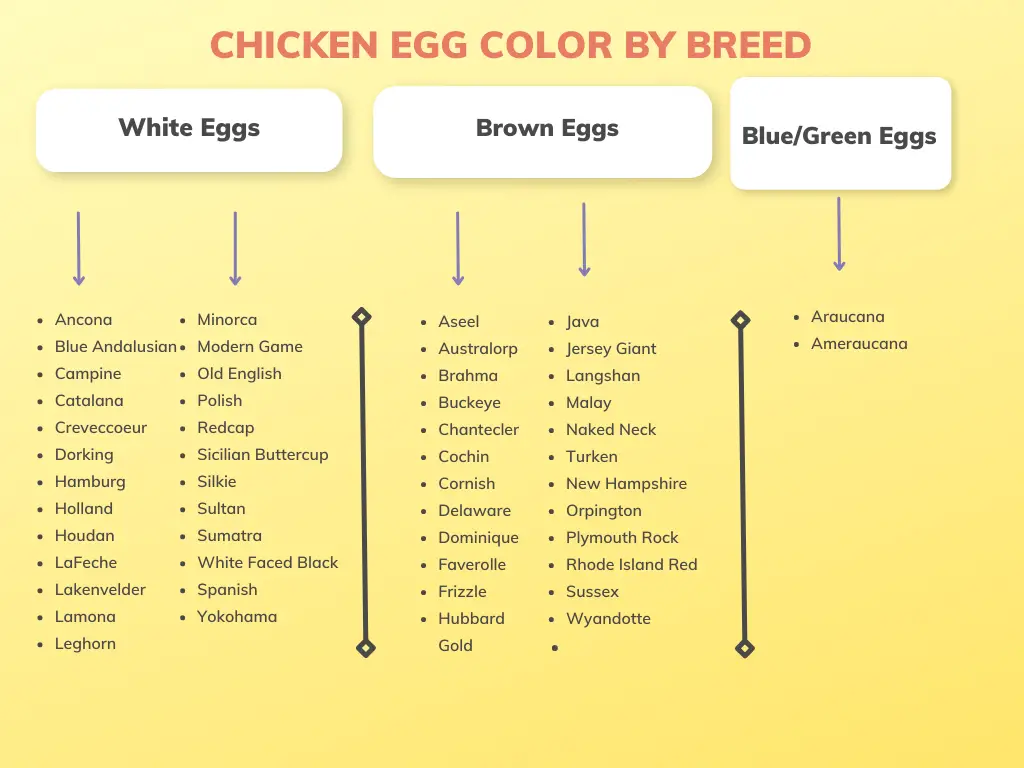As a general rule Chickens that lay white eggs have white earlobes, Chickens that lay brown eggs have red earlobes
Chickens that lay White Eggs
Do you want to know how to get Chickens that lay White Eggs? It’s actually not too difficult – all you need is the right information. In this blog post, we will discuss everything you need to know about Chickens that lay White Eggs, including what breeds are best for this purpose. We’ll also talk about the benefits of owning Chickens that lay White Eggs, and how to take care of them so that they produce the most eggs possible. So if you’re interested in learning more about Chickens that lay White Eggs, read on!
What Makes a Chickens Eggshell be white?
As it turns out, the pigmentation of a chicken’s eggshell is determined by the presence of two different types of melanin. One type is called pheomelanin and it’s what gives feathers their red or yellow coloration. The other type is eumelanin and it’s responsible for black and brown hues. Chickens that lay White Eggs – Jump to 12 Ways to Make Money by Chicken Farming **CHARTS**
White eggs are generally laid by chickens that have a lot of pheomelanin in their feathers. This is because the pheomelanin can diffuse through the eggshell and give it a white color. Chickens that have more eumelanin in their feathers tend to lay eggs with darker shells.
Interestingly, there is no nutritional difference between white and brown eggs. They both have the same amount of protein, vitamins, and minerals. The only difference is the color of the shell.

The Breed of the Chicken is one Factor
Some breeds lay eggs with darker shells, while others lay eggs with lighter shells. The diet of the Chicken can also affect egg color – for example, if they eat foods high in carotenoids (like carrots), their eggs will likely be a deeper orange color. Pigments Color Chicken eggs?
The pigments that give chicken eggs their colors are called xanthophylls and biliverdin. Xanthophylls are yellow or red, while biliverdin is blue or green. Most of the time, these two pigments combine to create the various colors of chicken eggs.
However, sometimes one pigment will be more dominant than the other, resulting in an egg that is primarily one color or the other. For example, if a chicken’s diet is high in carotenoids, its eggs will likely be more yellow due to the increased xanthophylls.

Can Chicken Feed Determine Egg Color?
Yes – as we mentioned before, chicken feed can definitely affect egg color. If you want your chickens to lay white eggs, make sure their diet consists of foods like wheat and barley. You can also purchase special chicken feeds that are designed to produce white eggs.
Can a Hen Lay Different Color Eggs?
Yes – a hen can lay different colored eggs depending on her diet and the breed of chicken she is. However, it’s important to note that not all hens will lay different colored eggs – some will only produce one color, regardless of what they eat. So if you’re looking for a hen that will lay white eggs, make sure to do your research ahead of time.
How do you tell what Color Chickens Eggs will Be?
Generally, the color of a hen’s egg is consistent, but there can be some variation depending on the breed of chicken and its diet. As a general rule Chickens that lay white eggs have white earlobes, and Chickens that lay brown eggs have red earlobes

The Breeds that Produce White Eggs are: white laying hen breeds
- Ancona
- Blue Andalusian
- Campine
- Catalana
- Creveccoeur
- Dorking
- Hamburg
- Holland
- Houdan
- LaFeche
- Lakenvelder
- Lamona
- Leghorn
- Minorca
- Modern Game
- Old English
- Polish
- Redcap
- Sicilian Buttercup
- Silkie
- Sultan
- Sumatra
- White Faced Black
- Spanish
- Yokohama
Can You tell the Color of a Hens eggs by the Color of the Hens Ear Lobes?
Also, the color of a chicken’s ears can be an indicator of the color of its eggs if you are raising them yourself.
If you have ever wondered whether the color of a chicken’s earlobes can predict the color of its eggs, you are not alone. It is a common question that many people ask when they are first learning about chickens.
The answer to this question is a bit complicated. There are actually two different types of chickens – those that lay white eggs and those that lay brown eggs. The vast majority of commercial egg-laying chickens are of the white-egg variety, but there are also some breeders who specialize in brown-egg laying chickens.
So, what does this all mean for your earlobe-color prediction abilities? Well, if you happen to have a white-egg laying chicken, then it is very likely that her earlobes will be white as well. However, if you have a brown-egg-laying chicken, her earlobes are usually red.
While the color of a chicken’s earlobes can give you some clues about the type of eggs she is likely to lay, it is not a foolproof method. There are always exceptions to the rule, so don’t be too discouraged if your white-earlobe chicken lays a brown egg (or vice versa).
What are some benefits to owning Chickens that lay White Eggs?
There are a few reasons why you might want to own Chickens that lay white eggs.
- For starters, they’re perfect for people who want to avoid eating eggs with colored shells. Since their feed is easy to control, Chickens that lay white eggs can be a great choice for those who want to ensure their eggs are always white.
- Another benefit of owning Chickens that lay white eggs is that they’re less likely to get sick than other breeds. This is because the pigment biliverdin can actually protect chickens from bacteria and viruses. So if you’re looking for a healthy breed of chicken, Chickens that lay white eggs are a great option.
Can I Hatch My Own White Chicken Eggs?
Yes – it is possible to hatch your own white chicken eggs. However, in order to do so you will need an incubator and fertile eggs. If you don’t have access to fertile eggs, you can also purchase them from hatcheries or online retailers.

What Pigments Color Chicken Eggs?
As we mentioned before, the pigments that color chicken eggs are xanthophylls and biliverdin. These pigments combine to create the various colors of chicken eggs.
Xanthophylls are yellow or red, while biliverdin is blue or green. Most of the time, these two pigments will balance each other out, resulting in the typical white, brown or tan eggshell color. However, there can be some variation depending on the breed of chicken and its diet.
Are There Brown Chickens that lay White Eggs?
Some Brown chickens that lay white eggs are the Campine, Catalana, Creveccoeur, Dorking, Hamburg, Holland, Houdan, LaFeche, Lakenvelder. Lamona. Leghorn. Minorca. Modern Game Old English Polish Redcap Sicilian Buttercup Silkie Sultan Sumatra White Faced Black Spanish Yokohama chicken breeds.
What Chickens lay large White Eggs?
The breeds of Chickens that lay the largest white eggs are the Ancona, Blue Andalusian, Campine. Catalana. Crevecoeur.Dorking. Hamburg.Holland.Houdan.LaFeche.Lakenvelder.Lamona ..Leghorn.Modern Game. Old English. Polish. Redcap. Sicilian Buttercup. Silkie.Sultan. Sumatra White Faced Black Spanish Yokohama chicken breeds
What Types of Chickens lay Brown Eggs?
The breeds that lay brown eggs are the Ameraucana, Barnevelder, Brahma, Buckeye, Catalana, Chantecler, Cochin, Cornish Cross, Delaware Bay Rock Chicken Dutch Bantam Hamburg Heirloom Java Hen Jersey Giant Komorner Tumbler Maran Plymouth Rock Rhode Island Red Rosecomb Sussex Warré Welsh Harlequin Wyandotte chicken breeds
What is a Dual-Purpose Chicken that lays White Eggs?
A dual-purpose chicken is a breed that is used for both egg and meat production. The most common dual-purpose chicken in the United States is the Rhode Island Red. Other popular dual-purpose chickens include New Hampshire, Delaware, and Plymouth Rock.
These breeds are good for both egg and meat production because they have a fast growth rate and are relatively disease-resistant. Some of the other benefits of dual-purpose chickens include their ability to forage for food and their cold hardiness. Dual-purpose chickens are also known to be good layers, with most breeds laying between 200 and 300 eggs per year.
The Rhode Island Red is the most popular breed of chicken in the United States. This versatile bird can be used for both egg and meat production, making it a great choice for small farmers
Final Thoughts – Chickens that lay White Eggs
In conclusion, Chickens that lay White Eggs are a great choice for anyone looking for an easy-to-care-for pet chicken. They are very low maintenance and can be kept in almost any setting. Plus, their eggs are delicious and nutritious! If you’re interested in getting Chickens that lay White Eggs, be sure to read up on the different breeds available so you can find the right one for you.
In conclusion, Chickens that lay white eggs are a great choice for people who want to avoid eating colored eggs, want a healthy breed of chicken, or simply want Chickens that will lay eggs consistently. So if you’re thinking about getting some chickens for your backyard, consider choosing a breed that lays white eggs!





